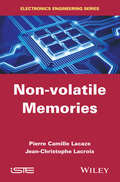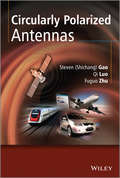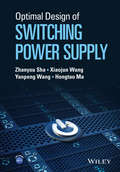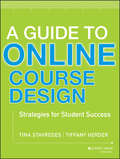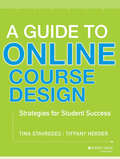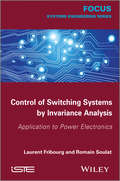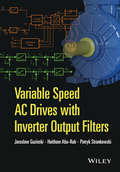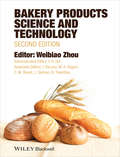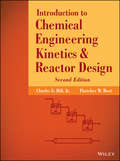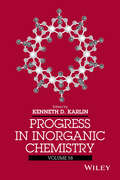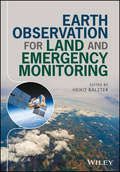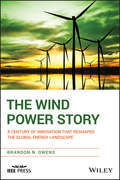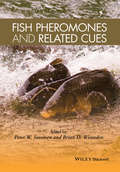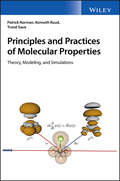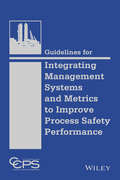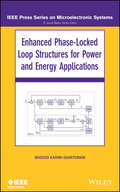- Table View
- List View
Non-volatile Memories
by Pierre-Camille Lacaze Jean-Claude LacroixWritten for scientists, researchers, and engineers, Non-volatile Memories describes the recent research and implementations in relation to the design of a new generation of non-volatile electronic memories. The objective is to replace existing memories (DRAM, SRAM, EEPROM, Flash, etc.) with a universal memory model likely to reach better performances than the current types of memory: extremely high commutation speeds, high implantation densities and retention time of information of about ten years.
Circularly Polarized Antennas (Wiley - IEEE)
by Steven Shichang Gao Qi Luo Fuguo ZhuThis book presents a comprehensive insight into the design techniques for different types of CP antenna elements and arrays In this book, the authors address a broad range of topics on circularly polarized (CP) antennas. Firstly, it introduces to the reader basic principles, design techniques and characteristics of various types of CP antennas, such as CP patch antennas, CP helix antennas, quadrifilar helix antennas (QHA), printed quadrifilar helix antennas (PQHA), spiral antenna, CP slot antennas, CP dielectric resonator antennas, loop antennas, crossed dipoles, monopoles and CP horns. Advanced designs such as small-size CP antennas, broadband, wideband and ultra-wideband CP antennas are also discussed, as well as multi-band CP antennas and dual CP antennas. The design and analysis of different types of CP array antennas such as broadband CP patch arrays, dual-band CP arrays, CP printed slot arrays, single-band and multi-band CP reflectarrays, high-gain CP waveguide slot antennas, CP dielectric resonator antenna arrays, CP active arrays, millimetre-waveband CP arrays in LTCC, and CP arrays with electronically beam-switching or beam-steering capabilities are described in detail. Case studies are provided to illustrate the design and implementation of CP antennas in practical scenarios such as dual-band Global Navigation Satellite Systems (GNSS) receivers, satellite communication mobile terminals at the S-band, Radio Frequency Identification (RFID) readers at 2.4 GHz, and Ka-band high-speed satellite communication applications. It also includes the detailed designs for a wideband Logarithmic spiral antenna that can operate from 3.4-7.7 GHz. In addition, the book offers a detailed review of the recent developments of different types of CP antennas and arrays. Presents comprehensive discussions of design techniques for different types of CP antennas: small-size CP antennas, broadband CP antennas, multi-band CP antennas and CP arrays. Covers a wide range of antenna technologies such as microstrip antennas, helix, quadrifilar helix antenna, printed quadrifilar helix antenna, dielectric resonator antennas, printed slots, spiral antennas, monopoles, waveguide slot arrays, reflectarrays, active arrays, millimetre-wave arrays in LTCC, electronically beam-switching arrays and electronically beam-steerable arrays. Reviews recent developments in different types of CP antennas and arrays, reported by industries, researchers and academics worldwide. Includes numerous case studies to demonstrate how to design and implement different CP antennas in practical scenarios. Provides both an introduction for students in the field and an in-depth reference for antenna/RF engineers who work on the development of CP antennas. Circularly Polarized Antennas will be an invaluable guide for researchers in R&D organizations; system engineers (antenna, telecom, space and satellite); postgraduates studying the subjects of antenna and propagation, electromagnetics, RF/microwave/millimetre-wave systems, satellite communications and so on; technical managers and professionals in the areas of antennas and propagation.
Circularly Polarized Antennas (Wiley - IEEE)
by Steven Shichang Gao Qi Luo Fuguo ZhuThis book presents a comprehensive insight into the design techniques for different types of CP antenna elements and arrays In this book, the authors address a broad range of topics on circularly polarized (CP) antennas. Firstly, it introduces to the reader basic principles, design techniques and characteristics of various types of CP antennas, such as CP patch antennas, CP helix antennas, quadrifilar helix antennas (QHA), printed quadrifilar helix antennas (PQHA), spiral antenna, CP slot antennas, CP dielectric resonator antennas, loop antennas, crossed dipoles, monopoles and CP horns. Advanced designs such as small-size CP antennas, broadband, wideband and ultra-wideband CP antennas are also discussed, as well as multi-band CP antennas and dual CP antennas. The design and analysis of different types of CP array antennas such as broadband CP patch arrays, dual-band CP arrays, CP printed slot arrays, single-band and multi-band CP reflectarrays, high-gain CP waveguide slot antennas, CP dielectric resonator antenna arrays, CP active arrays, millimetre-waveband CP arrays in LTCC, and CP arrays with electronically beam-switching or beam-steering capabilities are described in detail. Case studies are provided to illustrate the design and implementation of CP antennas in practical scenarios such as dual-band Global Navigation Satellite Systems (GNSS) receivers, satellite communication mobile terminals at the S-band, Radio Frequency Identification (RFID) readers at 2.4 GHz, and Ka-band high-speed satellite communication applications. It also includes the detailed designs for a wideband Logarithmic spiral antenna that can operate from 3.4-7.7 GHz. In addition, the book offers a detailed review of the recent developments of different types of CP antennas and arrays. Presents comprehensive discussions of design techniques for different types of CP antennas: small-size CP antennas, broadband CP antennas, multi-band CP antennas and CP arrays. Covers a wide range of antenna technologies such as microstrip antennas, helix, quadrifilar helix antenna, printed quadrifilar helix antenna, dielectric resonator antennas, printed slots, spiral antennas, monopoles, waveguide slot arrays, reflectarrays, active arrays, millimetre-wave arrays in LTCC, electronically beam-switching arrays and electronically beam-steerable arrays. Reviews recent developments in different types of CP antennas and arrays, reported by industries, researchers and academics worldwide. Includes numerous case studies to demonstrate how to design and implement different CP antennas in practical scenarios. Provides both an introduction for students in the field and an in-depth reference for antenna/RF engineers who work on the development of CP antennas. Circularly Polarized Antennas will be an invaluable guide for researchers in R&D organizations; system engineers (antenna, telecom, space and satellite); postgraduates studying the subjects of antenna and propagation, electromagnetics, RF/microwave/millimetre-wave systems, satellite communications and so on; technical managers and professionals in the areas of antennas and propagation.
Optimal Design of Switching Power Supply
by Zhanyou Sha Xiaojun Wang Yanpeng Wang Hongtao MaA contemporary evaluation of switching power design methods with real world applications• Written by a leading author renowned in his field• Focuses on switching power supply design, manufacture and debugging• Switching power supplies have relevance for contemporary applications including mobile phone chargers, laptops and PCs• Based on the authors' successful "Switching Power Optimized Design 2nd Edition" (in Chinese)• Highly illustrated with design examples of real world applications
Optimal Design of Switching Power Supply
by Zhanyou Sha Xiaojun Wang Yanpeng Wang Hongtao MaA contemporary evaluation of switching power design methods with real world applications• Written by a leading author renowned in his field• Focuses on switching power supply design, manufacture and debugging• Switching power supplies have relevance for contemporary applications including mobile phone chargers, laptops and PCs• Based on the authors' successful "Switching Power Optimized Design 2nd Edition" (in Chinese)• Highly illustrated with design examples of real world applications
A Guide to Online Course Design: Strategies for Student Success
by Tina Stavredes Tiffany HerderA Guide to Online Course Design offers faculty and professional staff a practical and easy-to-follow model for creating exceptional online courses that focuses on quality standards in instructional design, transparency in learning outcomes, and learner persistence. A comprehensive resource, the book includes effective, research-based instructional strategies to motivate online learners and help them become more self-directed. A Guide to Online Course Design emphasizes quality standards and removing barriers to learners’ persistence, which ensures online courses meet the needs of online learners as well as distance education initiatives. “All faculty members and course designers, regardless of experience level, content background, or technology skills, can benefit from applying the approaches defined in this book. The authors have imparted a wealth of knowledge that can improve the quality of any online class and I highly recommend this book for all those involved with online learning.” - Anton G. Camarota, faculty, University of Denver “Anyone involved in developing online courses should read this book! Packed with great insights and the research to back them up, Stavredes and Herder guide readers with practical information that will support online course development.” - Brenda Boyd, director of professional development and consulting, Quality Matters Program “The blend of theory and application makes A Guide to Online Course Design and indispensable resource for any professional seeking to create high quality, outcomes-based learning experiences. I loved the action steps that close each chapter, as they lead the reader through the entire process of course design from analysis to implementation.” - Kathe Kacheroski, dean of curriculum and instruction, Rasmussen College
A Guide to Online Course Design: Strategies for Student Success
by Tina Stavredes Tiffany HerderA Guide to Online Course Design offers faculty and professional staff a practical and easy-to-follow model for creating exceptional online courses that focuses on quality standards in instructional design, transparency in learning outcomes, and learner persistence. A comprehensive resource, the book includes effective, research-based instructional strategies to motivate online learners and help them become more self-directed. A Guide to Online Course Design emphasizes quality standards and removing barriers to learners’ persistence, which ensures online courses meet the needs of online learners as well as distance education initiatives. “All faculty members and course designers, regardless of experience level, content background, or technology skills, can benefit from applying the approaches defined in this book. The authors have imparted a wealth of knowledge that can improve the quality of any online class and I highly recommend this book for all those involved with online learning.” - Anton G. Camarota, faculty, University of Denver “Anyone involved in developing online courses should read this book! Packed with great insights and the research to back them up, Stavredes and Herder guide readers with practical information that will support online course development.” - Brenda Boyd, director of professional development and consulting, Quality Matters Program “The blend of theory and application makes A Guide to Online Course Design and indispensable resource for any professional seeking to create high quality, outcomes-based learning experiences. I loved the action steps that close each chapter, as they lead the reader through the entire process of course design from analysis to implementation.” - Kathe Kacheroski, dean of curriculum and instruction, Rasmussen College
Control of Switching Systems by Invariance Analysis: Applcation to Power Electronics
by Laurent Fribourg Romain SoulatThis book presents correct-by-design control techniques for switching systems, using different methods of stability analysis. Switching systems are increasingly used in the electronics and mechanical industries; in power electronics and the automotive industry, for example. This is due to their flexibility and simplicity in accurately controlling industrial mechanisms. By adopting appropriate control rules, we can steer a switching system to a region centered at a desired equilibrium point, while avoiding “unsafe” regions of parameter saturation. The authors explain various correct-by-design methods for control synthesis, using different methods of stability and invariance analysis. They also provide several applications of these methods to industrial examples of power electronics. Contents 1. Control Theory: Basic Concepts. 2. Sampled Switched Systems. 3. Safety Controllers. 4. Stability Controllers. 5. Application to Multilevel Converters. 6. Other Issues: Reachability, Sensitivity, Robustness and Nonlinearity. About the Authors Laurent Fribourg is head of the LSV (Laboratoire Spécification et Vérification) and Scientific Coordinator of the Institut Farman, Institut Fédératif de Recherche CNRS, which brings together the expertise of five laboratories from ENS Cachan, in France, in the fields of modeling, simulation and validation of complex systems. He has published over 70 articles in international journals and reviewed proceedings of international conferences, in the domain of the theory of formal methods and their industrial applications. Romain Soulat is in the third year of his doctorate at the LSV at ENS Cachan in France, under the supervision of Laurent Fribourg. He is working on the modeling and verification of hybrid systems. In particular, his interests concern robustness in scheduling problems – especially as part of a collaborative project with EADS Astrium on the verification of a component in the launcher for the future Ariane 6 rocket. He has published 5 articles in reviewed proceedings of international conferences.
Control of Switching Systems by Invariance Analysis: Applcation to Power Electronics (Focus Ser.)
by Laurent Fribourg Romain SoulatThis book presents correct-by-design control techniques for switching systems, using different methods of stability analysis. Switching systems are increasingly used in the electronics and mechanical industries; in power electronics and the automotive industry, for example. This is due to their flexibility and simplicity in accurately controlling industrial mechanisms. By adopting appropriate control rules, we can steer a switching system to a region centered at a desired equilibrium point, while avoiding “unsafe” regions of parameter saturation. The authors explain various correct-by-design methods for control synthesis, using different methods of stability and invariance analysis. They also provide several applications of these methods to industrial examples of power electronics. Contents 1. Control Theory: Basic Concepts. 2. Sampled Switched Systems. 3. Safety Controllers. 4. Stability Controllers. 5. Application to Multilevel Converters. 6. Other Issues: Reachability, Sensitivity, Robustness and Nonlinearity. About the Authors Laurent Fribourg is head of the LSV (Laboratoire Spécification et Vérification) and Scientific Coordinator of the Institut Farman, Institut Fédératif de Recherche CNRS, which brings together the expertise of five laboratories from ENS Cachan, in France, in the fields of modeling, simulation and validation of complex systems. He has published over 70 articles in international journals and reviewed proceedings of international conferences, in the domain of the theory of formal methods and their industrial applications. Romain Soulat is in the third year of his doctorate at the LSV at ENS Cachan in France, under the supervision of Laurent Fribourg. He is working on the modeling and verification of hybrid systems. In particular, his interests concern robustness in scheduling problems – especially as part of a collaborative project with EADS Astrium on the verification of a component in the launcher for the future Ariane 6 rocket. He has published 5 articles in reviewed proceedings of international conferences.
Variable Speed AC Drives with Inverter Output Filters (IEEE Press Series on Power Engineering)
by Jaroslaw Guzinski Haitham Abu-Rub Patryk StrankowskiThe advance of variable speed drives systems (VSDs) engineering highlights the need of specific technical guidance provision by electrical machines and drives manufacturers, so that such applications can be properly designed to present advantages in terms of both energy efficiency and expenditure. This book presents problems and solutions related to inverter-fed electrical motors. Practically orientated, the book describes the reasons, theory and analysis of those problems. Various solutions for individual problems are presented together with the complete design process, modelling and simulation examples with MATLAB/Simulink on the companion website. A key focus of Variable Speed AC Drives with Inverter Output Filters is to examine the state variables estimation and motor control structures which have to be modified according to the used solution (filter). In most control systems the structure and parameters are taken into account to make it possible for precise control of the motor. This methodology is able to include modifications and extensions depending on specific control and estimation structures. Highly accessible, this is an invaluable resource for practising R&D engineers in drive companies, power electronics & control engineers and manufacturers of electrical drives. Senior undergraduate and postgraduate students in electronics and control engineering will also find it of value.
Bakery Products Science and Technology
by Weibiao Zhou Y. H. HuiBaking is a process that has been practiced for centuries, and bakery products range in complexity from the simple ingredients of a plain pastry to the numerous components of a cake. While currently there are many books available aimed at food service operators, culinary art instruction and consumers, relatively few professional publications exist that cover the science and technology of baking. In this book, professionals from industry, government and academia contribute their perspectives on the state of industrial baking today. The second edition of this successful and comprehensive overview of bakery science is revised and expanded, featuring chapters on various bread and non-bread products from around the world, as well as nutrition and packaging, processing, quality control, global bread varieties and other popular bakery products. The book is structured to follow the baking process, from the basics, flour and other ingredients, to mixing, proofing and baking. Blending the technical aspects of baking with the latest scientific research, Bakery Products Science and Technology, Second Edition has all the finest ingredients to serve the most demanding appetites of food science professionals, researchers, and students.
Bakery Products Science and Technology
by Weibiao Zhou Y. H. HuiBaking is a process that has been practiced for centuries, and bakery products range in complexity from the simple ingredients of a plain pastry to the numerous components of a cake. While currently there are many books available aimed at food service operators, culinary art instruction and consumers, relatively few professional publications exist that cover the science and technology of baking. In this book, professionals from industry, government and academia contribute their perspectives on the state of industrial baking today. The second edition of this successful and comprehensive overview of bakery science is revised and expanded, featuring chapters on various bread and non-bread products from around the world, as well as nutrition and packaging, processing, quality control, global bread varieties and other popular bakery products. The book is structured to follow the baking process, from the basics, flour and other ingredients, to mixing, proofing and baking. Blending the technical aspects of baking with the latest scientific research, Bakery Products Science and Technology, Second Edition has all the finest ingredients to serve the most demanding appetites of food science professionals, researchers, and students.
Introduction to Chemical Engineering Kinetics and Reactor Design
by Charles G. Hill Thatcher W. RootThe Second Edition features new problems that engage readers in contemporary reactor design Highly praised by instructors, students, and chemical engineers, Introduction to Chemical Engineering Kinetics & Reactor Design has been extensively revised and updated in this Second Edition. The text continues to offer a solid background in chemical reaction kinetics as well as in material and energy balances, preparing readers with the foundation necessary for success in the design of chemical reactors. Moreover, it reflects not only the basic engineering science, but also the mathematical tools used by today’s engineers to solve problems associated with the design of chemical reactors. Introduction to Chemical Engineering Kinetics & Reactor Design enables readers to progressively build their knowledge and skills by applying the laws of conservation of mass and energy to increasingly more difficult challenges in reactor design. The first one-third of the text emphasizes general principles of chemical reaction kinetics, setting the stage for the subsequent treatment of reactors intended to carry out homogeneous reactions, heterogeneous catalytic reactions, and biochemical transformations. Topics include: Thermodynamics of chemical reactions Determination of reaction rate expressions Elements of heterogeneous catalysis Basic concepts in reactor design and ideal reactor models Temperature and energy effects in chemical reactors Basic and applied aspects of biochemical transformations and bioreactors About 70% of the problems in this Second Edition are new. These problems, frequently based on articles culled from the research literature, help readers develop a solid understanding of the material. Many of these new problems also offer readers opportunities to use current software applications such as Mathcad and MATLAB®. By enabling readers to progressively build and apply their knowledge, the Second Edition of Introduction to Chemical Engineering Kinetics & Reactor Design remains a premier text for students in chemical engineering and a valuable resource for practicing engineers.
Progress in Inorganic Chemistry (Progress in Inorganic Chemistry)
by Kenneth D. KarlinThis series provides inorganic chemists and materials scientists with a forum for critical, authoritative evaluations of advances in every area of the discipline. Volume 58 continues to report recent advances with a significant, up-to-date selection of contributions by internationally-recognized researchers. The chapters of this volume are devoted to the following topics: • Tris(dithiolene) Chemistry: A Golden Jubilee • How to find an HNO needle in a (bio)-chemical Haystack • Photoactive Metal Nitrosyl and Carbonyl Complexes Derived from Designed Auxiliary Ligands: An Emerging Class of Photochemotherapeutics • Metal--Metal Bond-Containing Complexes as Catalysts for C--H Functionalization Iron Catalysis in Synthetic Chemistry • Reactive Transition Metal Nitride Complexes Suitable for inorganic chemists and materials scientists in academia, government, and industries including pharmaceutical, fine chemical, biotech, and agricultural.
Progress in Inorganic Chemistry (Progress in Inorganic Chemistry #115)
by Kenneth D. KarlinThis series provides inorganic chemists and materials scientists with a forum for critical, authoritative evaluations of advances in every area of the discipline. Volume 58 continues to report recent advances with a significant, up-to-date selection of contributions by internationally-recognized researchers. The chapters of this volume are devoted to the following topics: • Tris(dithiolene) Chemistry: A Golden Jubilee • How to find an HNO needle in a (bio)-chemical Haystack • Photoactive Metal Nitrosyl and Carbonyl Complexes Derived from Designed Auxiliary Ligands: An Emerging Class of Photochemotherapeutics • Metal--Metal Bond-Containing Complexes as Catalysts for C--H Functionalization Iron Catalysis in Synthetic Chemistry • Reactive Transition Metal Nitride Complexes Suitable for inorganic chemists and materials scientists in academia, government, and industries including pharmaceutical, fine chemical, biotech, and agricultural.
Earth Observation for Land and Emergency Monitoring
by Heiko BalzterEarth Observation Science (EOS) is the study of the global Earth land-ocean-atmosphere system through observations. The principal tools for such studies are measurements from space since these provide the coverage of the planet that is necessary to capture the behaviour of the entire coupled system. In addition, surface observations, and measurements from aircraft, balloons and sounding rockets provide valuable contributors to what are now termed "integrated, global observing systems.” Coupled with models, the EOS measurement suites provide powerful tools for research into the factors controlling and changing the Earth system in which we live. The objectives of this book are to describe new methods and applications of satellite technology in the fields of land and emergency monitoring. It draws on new research outcomes from the European FP7 project GIONET (European Centre of Excellence in Earth Observation Research Training). GIONET combines industrial partners with universities and research institutes, and this book provides a perspective on Earth Observation applications that is motivated by the cross-fertilisation of both sectors. Hence, this book will find readers in both industry and academia. This book highlights a broad range of innovative uses of Earth Observation technology to support environmental management, decision making, crisis management and climate policies. It uses advanced concepts of multi-sensor image integration, multi-temporal analysis and synergies between data and models. This is a truly interdisciplinary subject that encompasses a range of applications in various fields which are discussed in detail throughout the text. If you are interested in remote sensing applications and looking for inspiration, this is the book for you.
Earth Observation for Land and Emergency Monitoring
by Heiko BalzterEarth Observation Science (EOS) is the study of the global Earth land-ocean-atmosphere system through observations. The principal tools for such studies are measurements from space since these provide the coverage of the planet that is necessary to capture the behaviour of the entire coupled system. In addition, surface observations, and measurements from aircraft, balloons and sounding rockets provide valuable contributors to what are now termed "integrated, global observing systems.” Coupled with models, the EOS measurement suites provide powerful tools for research into the factors controlling and changing the Earth system in which we live. The objectives of this book are to describe new methods and applications of satellite technology in the fields of land and emergency monitoring. It draws on new research outcomes from the European FP7 project GIONET (European Centre of Excellence in Earth Observation Research Training). GIONET combines industrial partners with universities and research institutes, and this book provides a perspective on Earth Observation applications that is motivated by the cross-fertilisation of both sectors. Hence, this book will find readers in both industry and academia. This book highlights a broad range of innovative uses of Earth Observation technology to support environmental management, decision making, crisis management and climate policies. It uses advanced concepts of multi-sensor image integration, multi-temporal analysis and synergies between data and models. This is a truly interdisciplinary subject that encompasses a range of applications in various fields which are discussed in detail throughout the text. If you are interested in remote sensing applications and looking for inspiration, this is the book for you.
The Wind Power Story: A Century of Innovation that Reshaped the Global Energy Landscape
by Brandon N. OwensHelps readers understand and appreciate what the history of wind power can teach us about technology innovation and provides the implications for both wind power today and its future This book takes readers on a journey through the history of wind power in order to show how the technology evolved over the course of the twentieth century and where it may be headed in the twenty-first century. It introduces and examines broad themes such as government funding of wind power, the role of fossil fuels in wind power development, and the importance of entrepreneurs in wind power development. It also discusses the lessons learned from wind power technology innovation and makes them relevant to the understanding of wind power today and in the future. Spanning the entire history of wind power (1888-2018), The Wind Power Story: A Century of Innovation that Reshaped the Global Energy Landscape provides balanced coverage of each decade as well as the important wind power technology innovations that occurred during that time. Compelling from the first page to the last, it offers chapters covering the pioneers of wind power; the age of small wind; wind power in the wake of war; wind power’s use across Europe; government-funded research programs; how Denmark reinvented wind power in the 1970s; the California Wind Rush of the 1980s; wind power’s rise in Spain; America’s wind power starting in the 1990s; India’s wind power path; the wind power surge in China; the globalization of wind power; and much more. In addition, this text: Spans the entire global history of wind power, while weaving together both the historical context and the technical details of wind power innovation Provides historical context for wind power developments and explains the evolution of wind turbine technology in an easy-to-understand manner Discusses the policy, technology, and market evolution of wind power in commonly understood language Offers a review of the surrounding power technology, policy, and market environment throughout the history of wind power A book that both specialists and non-specialists can read in order to understand and appreciate the past, present, and future of wind power technology, The Wind Power Story: A Century of Innovation that Reshaped the Global Energy Landscape will be of great interest to any engineer and any interested readers looking to understand wind power technologies, markets, and policies in one book.
The Wind Power Story: A Century of Innovation that Reshaped the Global Energy Landscape
by Brandon N. OwensHelps readers understand and appreciate what the history of wind power can teach us about technology innovation and provides the implications for both wind power today and its future This book takes readers on a journey through the history of wind power in order to show how the technology evolved over the course of the twentieth century and where it may be headed in the twenty-first century. It introduces and examines broad themes such as government funding of wind power, the role of fossil fuels in wind power development, and the importance of entrepreneurs in wind power development. It also discusses the lessons learned from wind power technology innovation and makes them relevant to the understanding of wind power today and in the future. Spanning the entire history of wind power (1888-2018), The Wind Power Story: A Century of Innovation that Reshaped the Global Energy Landscape provides balanced coverage of each decade as well as the important wind power technology innovations that occurred during that time. Compelling from the first page to the last, it offers chapters covering the pioneers of wind power; the age of small wind; wind power in the wake of war; wind power’s use across Europe; government-funded research programs; how Denmark reinvented wind power in the 1970s; the California Wind Rush of the 1980s; wind power’s rise in Spain; America’s wind power starting in the 1990s; India’s wind power path; the wind power surge in China; the globalization of wind power; and much more. In addition, this text: Spans the entire global history of wind power, while weaving together both the historical context and the technical details of wind power innovation Provides historical context for wind power developments and explains the evolution of wind turbine technology in an easy-to-understand manner Discusses the policy, technology, and market evolution of wind power in commonly understood language Offers a review of the surrounding power technology, policy, and market environment throughout the history of wind power A book that both specialists and non-specialists can read in order to understand and appreciate the past, present, and future of wind power technology, The Wind Power Story: A Century of Innovation that Reshaped the Global Energy Landscape will be of great interest to any engineer and any interested readers looking to understand wind power technologies, markets, and policies in one book.
Fish Pheromones and Related Cues
by Peter W. Sorensen Brian D. WisendenPheromones are chemical cues that pass between members of the same species that convey specific, adaptive information. These cues, and related chemicals whose function are less well defined, are especially important to fishes because of their aquatic environments and complex behaviors. Pheromones are also of increasing interest in both basic and applied aspects of fish biology because they can be used to manipulate fish behavior and may explain phenomena such as fishery collapse. Fish Pheromones and Related Cues provides a timely synthesis of this growing body of research in freshwater and marine species and explores everything from how these chemical signals evolved, are produced, released and then processed, and finally to potential applications in fish culture and conservation. Fish Pheromones and Related Cues opens with a useful overview on the theory of chemical communication and definitions. Chapters then progress by examining the biological importance of pheromones in inter- and intra-species communication, the role these chemical cues play in a variety biological functions from reproduction to predation, and then how they evolved and are detected and recognized by fish nervous systems. Final chapters provide valuable insight into how pheromones can be measured, how pheromonal disruption can explain effects of environmental pollution, and lastly how they pheromones are being applied in real-world efforts to culture fish species and to conserve our wild populations and control invasive species. With far-reaching economic, evolutionary and ecological implications, Fish Pheromones and Related Cues will be an essential volume for anyone working in the fields of chemical communication, fish biology, fisheries science, aquatic conservation, ecology, invasive species control, and aquaculture
Principles and Practices of Molecular Properties: Theory, Modeling, and Simulations
by Patrick Norman Kenneth Ruud Trond SaueA comprehensive yet accessible exploration of quantum chemical methods for the determination of molecular properties of spectroscopic relevance Molecular properties can be probed both through experiment and simulation. This book bridges these two worlds, connecting the experimentalist's macroscopic view of responses of the electromagnetic field to the theoretician’s microscopic description of the molecular responses. Comprehensive in scope, it also offers conceptual illustrations of molecular response theory by means of time-dependent simulations of simple systems. This important resource in physical chemistry offers: A journey in electrodynamics from the molecular microscopic perspective to the conventional macroscopic viewpoint The construction of Hamiltonians that are appropriate for the quantum mechanical description of molecular properties Time- and frequency-domain perspectives of light–matter interactions and molecular responses of both electrons and nuclei An introduction to approximate state response theory that serves as an everyday tool for computational chemists A unified presentation of prominent molecular properties Principles and Practices of Molecular Properties: Theory, Modeling and Simulations is written by noted experts in the field. It is a guide for graduate students, postdoctoral researchers and professionals in academia and industry alike, providing a set of keys to the research literature.
Principles and Practices of Molecular Properties: Theory, Modeling, and Simulations
by Patrick Norman Kenneth Ruud Trond SaueA comprehensive yet accessible exploration of quantum chemical methods for the determination of molecular properties of spectroscopic relevance Molecular properties can be probed both through experiment and simulation. This book bridges these two worlds, connecting the experimentalist's macroscopic view of responses of the electromagnetic field to the theoretician’s microscopic description of the molecular responses. Comprehensive in scope, it also offers conceptual illustrations of molecular response theory by means of time-dependent simulations of simple systems. This important resource in physical chemistry offers: A journey in electrodynamics from the molecular microscopic perspective to the conventional macroscopic viewpoint The construction of Hamiltonians that are appropriate for the quantum mechanical description of molecular properties Time- and frequency-domain perspectives of light–matter interactions and molecular responses of both electrons and nuclei An introduction to approximate state response theory that serves as an everyday tool for computational chemists A unified presentation of prominent molecular properties Principles and Practices of Molecular Properties: Theory, Modeling and Simulations is written by noted experts in the field. It is a guide for graduate students, postdoctoral researchers and professionals in academia and industry alike, providing a set of keys to the research literature.
Guidelines for Integrating Management Systems and Metrics to Improve Process Safety Performance
by CCPS (Center for Chemical Process Safety)This book combines the synergies between performance improvement systems to help ensure safe and reliable operations, streamline procedures and cross-system auditing, and supporting regulatory and corporate compliance requirements. Many metrics are common to more than one area, such that a well-designed and implemented integrated management system will reduce the load on the Process Safety, SHE, Security and Quality groups, and improve manufacturing efficiency and customer satisfaction. Systems to improve performance include: process safety; traditional safety, health and environment; and, product quality. Chapters include: Integrating Framework; Securing Support & Preparing for Implementation; Establishing Common Risk Management Systems – How to Integrate PSM into Other EH; Testing Implementation Approach; Developing and Agreeing on Metrics; Management Review; Tracking Integration Progress and Measuring Performance; Continuous Improvement; Communication of Results to Different Stakeholders; Case Studies; and Examples for Industry.
Enhanced Phase-Locked Loop Structures for Power and Energy Applications (IEEE Press Series on Microelectronic Systems)
by Masoud Karimi-GhartemaFilling the gap in the market dedicated to PLL structures for power systems Internationally recognized expert Dr. Masoud Karimi-Ghartemani brings over twenty years of experience working with PLL structures to Enhanced Phase-Locked Loop Structures for Power and Energy Applications, the only book on the market specifically dedicated to PLL architectures as they apply to power engineering. As technology has grown and spread to new devices, PLL has increased in significance for power systems and the devices that connect with the power grid. This book discusses the PLL structures that are directly applicable to power systems using simple language, making it easily digestible for a wide audience of engineers, technicians, and graduate students. Enhanced phase-locked loop (EPLL) has become the most widely utilized architecture over the past decade, and many books lack explanation of the structural differences between PLL and EPLL. This book discusses those differences and also provides detailed instructions on using EPLL for both single-phase applications and three-phase applications. The book’s major topics include: A basic look at PLL and its standard structure A full explanation of EPLL EPLL extensions and modifications Digital implementation of EPLL Extensions of EPLL to three-phase structures Dr. Karimi-Ghartemani provides basic analysis that helps readers understand each of the structures presented without requiring complicated mathematical proofs. His book is filled with illustrated examples and simulations that connect theory to the real world, making Enhanced Phase-Locked Loop Structures for Power and Energy Applications an ideal reference for anyone working with inverters, rectifiers, and related technologies.
Enhanced Phase-Locked Loop Structures for Power and Energy Applications (IEEE Press Series on Microelectronic Systems)
by Masoud Karimi-GhartemaFilling the gap in the market dedicated to PLL structures for power systems Internationally recognized expert Dr. Masoud Karimi-Ghartemani brings over twenty years of experience working with PLL structures to Enhanced Phase-Locked Loop Structures for Power and Energy Applications, the only book on the market specifically dedicated to PLL architectures as they apply to power engineering. As technology has grown and spread to new devices, PLL has increased in significance for power systems and the devices that connect with the power grid. This book discusses the PLL structures that are directly applicable to power systems using simple language, making it easily digestible for a wide audience of engineers, technicians, and graduate students. Enhanced phase-locked loop (EPLL) has become the most widely utilized architecture over the past decade, and many books lack explanation of the structural differences between PLL and EPLL. This book discusses those differences and also provides detailed instructions on using EPLL for both single-phase applications and three-phase applications. The book’s major topics include: A basic look at PLL and its standard structure A full explanation of EPLL EPLL extensions and modifications Digital implementation of EPLL Extensions of EPLL to three-phase structures Dr. Karimi-Ghartemani provides basic analysis that helps readers understand each of the structures presented without requiring complicated mathematical proofs. His book is filled with illustrated examples and simulations that connect theory to the real world, making Enhanced Phase-Locked Loop Structures for Power and Energy Applications an ideal reference for anyone working with inverters, rectifiers, and related technologies.
